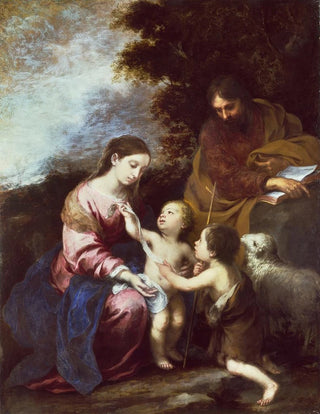Art print | The Holy Family with the Baptismal Child - Bartolomé Esteban Murillo


View from behind

Frame (optional)
Art print La Sainte Famille avec l'enfant Baptiste - Bartolomé Esteban Murillo – Engaging Introduction
In the rich and diverse panorama of Spanish Baroque art, the work "La Sainte Famille avec l'enfant Baptiste" by Bartolomé Esteban Murillo stands out for its emotional depth and its tenderness imbued with spirituality. This intimate depiction of the Holy Family, where tenderness and piety intertwine, transports the viewer into a universe of serenity and devotion. Murillo, master of light and color, manages to capture a warm atmosphere that evokes protection and familial love. The scene, where the child Jesus is surrounded by his mother Mary and Saint John the Baptist, embodies the quintessence of Christian faith while offering a touching vision of daily life in the 17th century.
Style and uniqueness of the work
The work is characterized by a flamboyant Baroque style, where light plays a central role. Murillo uses subtle contrasts between shadow and clarity to emphasize the expressions of the characters and create an almost tangible atmosphere. The faces are delicately modeled, revealing a range of emotions from joy to contemplation. The color palette, imbued with warm tones, reinforces the sense of proximity and intimacy between the figures. The drapery, carefully rendered, seems to vibrate under the light, adding a tactile dimension to the painting. Every detail, from the knowing look between the protagonists to the softness of the gestures, testifies to Murillo's genius in evoking deep feelings through a harmonious and balanced composition.
The artist and his influence
Bartolomé Esteban Murillo, born in Seville in 1617, is one of the most emblematic painters of the Spanish Golden Age. His work is marked by a unique sensitivity, blending realism and idealization. Murillo draws inspiration from great masters of painting, such as Velázquez and Caravaggio, while developing a distinctive style that allows him to stand out. His influence extends well beyond his time, inspiring many artists through the centuries. The representation of motherhood and spirituality in his works has particularly touched subsequent generations, making him

Matte finish

View from behind

Frame (optional)
Art print La Sainte Famille avec l'enfant Baptiste - Bartolomé Esteban Murillo – Engaging Introduction
In the rich and diverse panorama of Spanish Baroque art, the work "La Sainte Famille avec l'enfant Baptiste" by Bartolomé Esteban Murillo stands out for its emotional depth and its tenderness imbued with spirituality. This intimate depiction of the Holy Family, where tenderness and piety intertwine, transports the viewer into a universe of serenity and devotion. Murillo, master of light and color, manages to capture a warm atmosphere that evokes protection and familial love. The scene, where the child Jesus is surrounded by his mother Mary and Saint John the Baptist, embodies the quintessence of Christian faith while offering a touching vision of daily life in the 17th century.
Style and uniqueness of the work
The work is characterized by a flamboyant Baroque style, where light plays a central role. Murillo uses subtle contrasts between shadow and clarity to emphasize the expressions of the characters and create an almost tangible atmosphere. The faces are delicately modeled, revealing a range of emotions from joy to contemplation. The color palette, imbued with warm tones, reinforces the sense of proximity and intimacy between the figures. The drapery, carefully rendered, seems to vibrate under the light, adding a tactile dimension to the painting. Every detail, from the knowing look between the protagonists to the softness of the gestures, testifies to Murillo's genius in evoking deep feelings through a harmonious and balanced composition.
The artist and his influence
Bartolomé Esteban Murillo, born in Seville in 1617, is one of the most emblematic painters of the Spanish Golden Age. His work is marked by a unique sensitivity, blending realism and idealization. Murillo draws inspiration from great masters of painting, such as Velázquez and Caravaggio, while developing a distinctive style that allows him to stand out. His influence extends well beyond his time, inspiring many artists through the centuries. The representation of motherhood and spirituality in his works has particularly touched subsequent generations, making him






